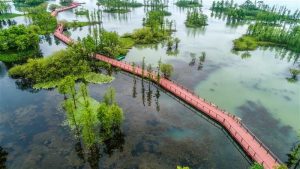World Wetlands Day is celebrated on 2 February every year and underscores the need to save and restore wetlands and raise awareness about their crucial role. Wetlands are some of the planet’s most powerful yet underappreciated ecosystems. These ecosystems where water saturates the land, including mangroves, peat lands, marshes, swamps, and coral reefs, provide a wealth of benefits. They act as habitats for diverse plants and animals, protect shores from waves, reduce the impacts of floods, and even support local livelihoods.

Adaptive capacity against climate disasters
Among the many functions of these wetlands, their capacity to help communities adapt to climate-related shocks stands out, particularly in coastal regions where the stakes are high. Coastal wetlands such as mangroves and salt marshes act as natural buffers against rising seas and extreme weather. These ecosystems adapt to sea level rise, aridity, and salinity through vertical accretion and inland migration. By trapping and slowly releasing floodwaters, snowmelt, and rainwater, they reduce the severity of flooding and erosion. For example, mangroves significantly reduced the impact of the 2004 tsunami by absorbing the wave energy and minimising coastal damage.
In addition to reducing the impacts of climate disasters, wetlands accelerate recovery following such an event. For instance, after the 1999 cyclone in Odisha, rice paddies protected by mangroves recovered their food production more quickly than croplands without such buffers.
Mitigation potential
While the adaptive capacity of wetlands helps communities cope with and recover from climate disasters, their mitigation potential lies in their ability to absorb and store carbon.
Coastal ecosystems absorb and store carbon at significantly higher rates than terrestrial forests. Mangroves can store up to 10 times more carbon than mature tropical forests, emphasising their role in climate change mitigation. However, mangroves in India, covering approximately 0.5 million hectares, store an estimated 125 tons of carbon per hectare, which is significantly lower than the global average of approximately 800 tons per hectare, according to the Forest Survey of India. Although differences in species composition may explain part of this discrepancy, the significantly lower rates underscore the urgent need for enhanced management and restoration efforts to boost carbon storage potential.
Further, India’s wetlands are under-represented in national inventories, with limited carbon sequestration estimates available. Regional studies show significant variation in carbon storage potential, ranging from 13.8 to 548 tons per hectare, highlighting the need for systematic assessments and periodic data collection.
Conclusion
Wetlands play a dual role in climate change mitigation and adaptation, offering significant potential for carbon sequestration while providing vital ecosystem services that help communities adapt to climate impacts like rising seas. However, their vast potential remains untapped owing to gaps in inventory and management. To protect these ecosystems and enhance resilience, science-backed policies that integrate traditional knowledge with modern technology are essential. Wetlands are not just environmental assets—they are critical to India’s future resilience, and by acting now, we can safeguard these vital ecosystems for a sustainable, climate-resilient future.
The authors work in the Climate Change Mitigation team in the Climate, Environment & Sustainability sector at the Center for Study of Science, Technology and Policy (CSTEP), a research-based think tank.
More About Publication |
|
|---|---|
| Date: | 02 February 2025 |
| Contributors: | |
| Publisher: | CSTEP |
| Related Areas: | |
Get in touch with us at
cpe@cstep.in